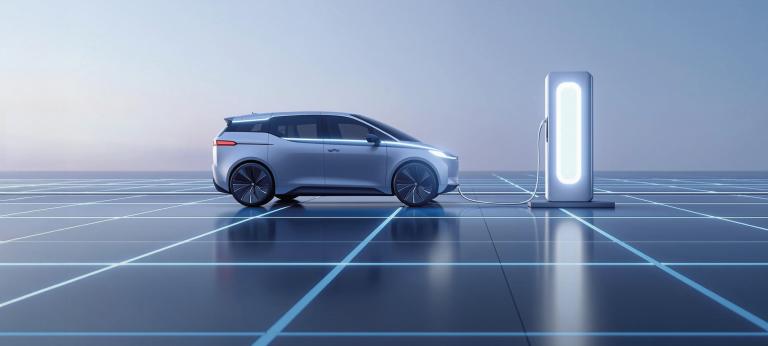EV Charging Index 2025: Steady progress
Despite tough market conditions, global EV use and charging infrastructure showed continued steady growth in 2024. Learn more in Roland Berger’s latest EV Charging Index.


Romania has fallen to the lower echelons of our Index and now ranks 27th of 33 nations. A sharp reduction in government subsidies followed by a temporary suspension caused a notable decline in EV sales throughout 2024 and into 2025. Meanwhile, the expansion of charging infrastructure has also slightly slowed. Despite these short-term headwinds, user satisfaction is rising and Romania’s long-term e-mobility potential remains promising.

Romania’s e-mobility sector is under increasing pressure. Amid wider fiscal constraints, the sharp reduction in government subsidies for EV purchases (Rabla Plus program), followed by their temporary suspension, saw BEV sales drop by a third in 2024. Overall EV sales penetration fell from 13% to 11% – under half the European average. The downward trend has persisted into 2025, with BEV registrations in the first half of the year declining by over 40% compared with H1 2024.
Dacia maintained its position as the leading EV brand in 2024, with 3,263 units sold of its Spring model, but saw a decline in sales of around 50%. Tesla showed a fall of roughly 20% to 2,550 units.
In contrast, Romania’s overall automotive market was more resilient, with total new car registrations reaching nearly 150,000 units in 2024 - a 5% year-on-year increase. This divergence underscores the heightened sensitivity of the EV segment to subsidy changes.
In 2024, the government halved EV vouchers from approximately EUR 10,000 to around EUR 5,100. Furthermore, fiscal pressures led to the suspension of the program in June 2025, with the government attributing the decision to fiscal constraints and a widening budget deficit. When this article was written, Rabla Plus programme was still pending relaunch, with a significantly lower budget and an EV voucher of only circa EUR 3,700, the disruption caused by its temporary suspension further exposing the sector’s vulnerability to policy uncertainty.
"Subsidy reductions and temporary suspension have slowed EV demand in Romania, but there is potential for renewed growth."
While EV sales declined, Romania's charging infrastructure posted a 33% year-on-year increase to just over 4,500 charging points. The rate may slowed compared with the previous year, but its continued growth reflects both ongoing private-sector investments and national recovery plan commitments.
For instance in May 2025, Romania opened its largest EV charging hub, on the A1 motorway, featuring 34 fast-charging points. Half the charge points have a 400 kW capacity specifically designed for electric trucks. This project, partially backed by European funding through the Connecting Europe Facility, represents part of a broader initiative to install 328 high-speed charging points across Romania in 2025.
However, progress toward the government’s target of 22,400 charge points by 2026 remains slow, with completion at around 20% at the end of 2024. While some major contracts have already been signed to further support EV charging infrastructure expansion, this ambitious timeline demands a major acceleration to stay on track for the 2026 milestone.
The latest EV Charging Index survey of EV drivers in Romania revealed distinctive usage patterns and persistent infrastructure concerns. Romanian users demonstrated one of the lowest home charging rates globally at approximately 40%, with 38% lacking access to any home charger. This dependency on public charging infrastructure places additional pressure on network sufficiency.
Despite infrastructure expansion, 60% of respondents considered public charging insufficient, while almost half cited charging times as too slow. On the positive side, the share of public fast-charging usage reached 26% of kilometers traveled, among the highest globally, reflecting the availability of DC fast-charging infrastructure. In Romania, 42% of public charge points are DC – more than double the European average of 17%.
Over 75% of survey respondents still consider purchasing a BEV again as their next car, though this represents one of the lowest shares among the 33 countries we analyzed. Usage patterns also differ significantly, with 37% of respondents reporting annual mileage below 10,000 km compared with a 20% average across all surveyed countries.
Cost considerations dominate purchase decisions, with 60% of buyers citing lower usage and maintenance costs as key decision criteria, while 50% mentioned environmental protection and around 30% highlighted suitable range and tax advantages.
Romania faces a critical juncture in its e-mobility journey. The government's fiscal consolidation efforts, targeting a 7%-8% budget deficit in 2025 down from 8.6% in 2024, directly impact subsidy availability. However, the infrastructure foundation continues be strengthened through private investment and EU funding mechanisms. The European Bank for Reconstruction and Development, for instance, has invested EUR 15 million in one of the largest charging infrastructure providers, signaling growing confidence in Romania's charging market potential.
The phasing out of free charging services and shift to paid models indicate a maturation of the market and its move toward financial sustainability. Moreover, the greater availability of affordable BEV models - including the market entry of Chinese brands - could partially offset subsidy cuts and increase price competition in the market.
As Romania navigates between fiscal responsibility and electrification goals, the market's resilience will depend on infrastructure development pace, subsidy program sustainability and consumer adaptation to evolving mobility options. The continued expansion of charging networks, entry of new automotive players and growing commercial vehicle electrification suggest underlying momentum despite current headwinds.
Register now to to discover the latest insights, emerging trends and upcoming challenges in the EV and EV charging markets.